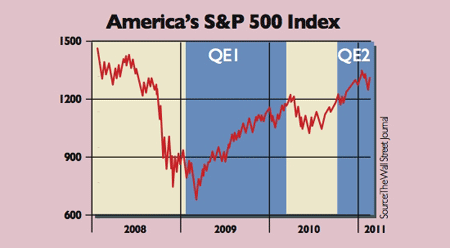Are QE-buoyed stocks about to sink?
Despite turmoil in the Middle East, Europe’s endless debt crisis, and the Japanese earthquake, US equities, which set the tone for world markets, were almost back to February’s highs this week. But are they about to plunge as QE comes to an end?
"We have had extraordinary events, but markets have pretty much shrugged them off," says Nick Gartside of JP Morgan Asset Management. Despite turmoil in the Middle East, Europe's endless debt crisis, and the Japanese earthquake, US equities, which set the tone for world markets, were almost back to February's highs this week.
QE has boosted equities
A key reason stocks have been so resilient is cheap money. Low interest rates are always good news for stocks, as they boost growth and earnings and make more money available for investment. Quantitative easing (QE) programmes have added to the global money supply by printing cash. Even bad economic news has been interpreted as good for stocks because it implies that low rates or QE will continue. Post-Japan, the market ignored bad news "as it prolongs the era of cheap money", says Richard Gilhooly of TD Securities.
So the prospect of QE2 (America's second money printing programme) ending in June implies that stocks could then struggle. For decades now it has been clear that "when markets' views about central banks' intentions change towards a belief in tightening", stocks "run into trouble", says John Authers in the FT.
MoneyWeek
Subscribe to MoneyWeek today and get your first six magazine issues absolutely FREE

Sign up to Money Morning
Don't miss the latest investment and personal finances news, market analysis, plus money-saving tips with our free twice-daily newsletter
Don't miss the latest investment and personal finances news, market analysis, plus money-saving tips with our free twice-daily newsletter
What happened when QE1 ended
Just look at what happened when QE1 came to an end in March 2010, having begun just over a year earlier, says Authers. The Fed began openly to ponder how it might remove all the liquidityit had created, and stocks went into a "swoon". In addition, the economy weakened, prompting the Fed to signal in August that another dose of printed money was on its way. At that point, stocks perked up (see chart below).

Morgan Stanley also notes that Japanese stocks weakened when a previous episode of QE there ended in 2006. And since 1976, there has been a correction of 8%-21% in pan-European equities around the time of the first interest-rate hike after a recession by the Fed. This time round, the Fed is unlikely to raise rates before next year, as Morgan Stanley points out. But rates are set to rise in Europe, which, along with the supposed end of QE2, will keep tightening on the agenda over the next few months.
Will there be QE3?
The end of QE2 isn't a done deal. While the latest data have been encouraging, the US recovery remains lacklustre by historical standards. Don't count on it lasting once the "sugar rush" of monetaryand fiscal policies ends, says Liam Halligan in The Sunday Telegraph. So we can't rule out QE3.
And even if QE2 does end, "QE3 may already be here", says Barry Ritholtz on Ritholtz.com/blog. The Japanese central bank last month "spewed the equivalent" of QE2 relative to the size of the Japanese economy into the bond market in just three days. So post-earthquake, there has been a further loosening of global monetary policy. Then there's the potential boost from a revival of the yen carry trade. With investors selling yen to fund purchases of risky assets, "another wave of global liquidity" is in the making, reckons Hans Redeker of BNP Paribas.
Stocks, of course, aren't just a liquidity story. But none of the fundamentals look particularly encouraging. Earnings momentum, as we noted a fortnight ago, appears to be slowing. Overly optimistic assumptions on profit margins are another reason to expect developed-market earnings to disappoint this year, says Morgan Stanley's Gerard Minack. The US market is also trading on a cyclically adjusted price/earnings ratio of 24, which is 46% above the long-term average.
So stocks look especially vulnerable to a correction amid fears of interest-rate hikes and the end of QE2. Given the unusually murky outlook, staying defensive looks the best bet not least because, as Morgan Stanley points out, defensive stocks outperform when markets become worried about monetary tightening.
Get the latest financial news, insights and expert analysis from our award-winning MoneyWeek team, to help you understand what really matters when it comes to your finances.
MoneyWeek is written by a team of experienced and award-winning journalists, plus expert columnists. As well as daily digital news and features, MoneyWeek also publishes a weekly magazine, covering investing and personal finance. From share tips, pensions, gold to practical investment tips - we provide a round-up to help you make money and keep it.
-
 ‘Why I have ditched my Help to Buy ISA for cash savings and the stock market’
‘Why I have ditched my Help to Buy ISA for cash savings and the stock market’Without the 25% bonus, my Help to Buy ISA is effectively redundant, says MoneyWeek writer Sam Walker.
-
 Is your inheritance tax allowance cut if you sell to downsize or sell your home to pay for care?
Is your inheritance tax allowance cut if you sell to downsize or sell your home to pay for care?Downsizing relief is a little-known benefit that could save your loved ones tens of thousands of pounds in inheritance tax after you’ve died.

